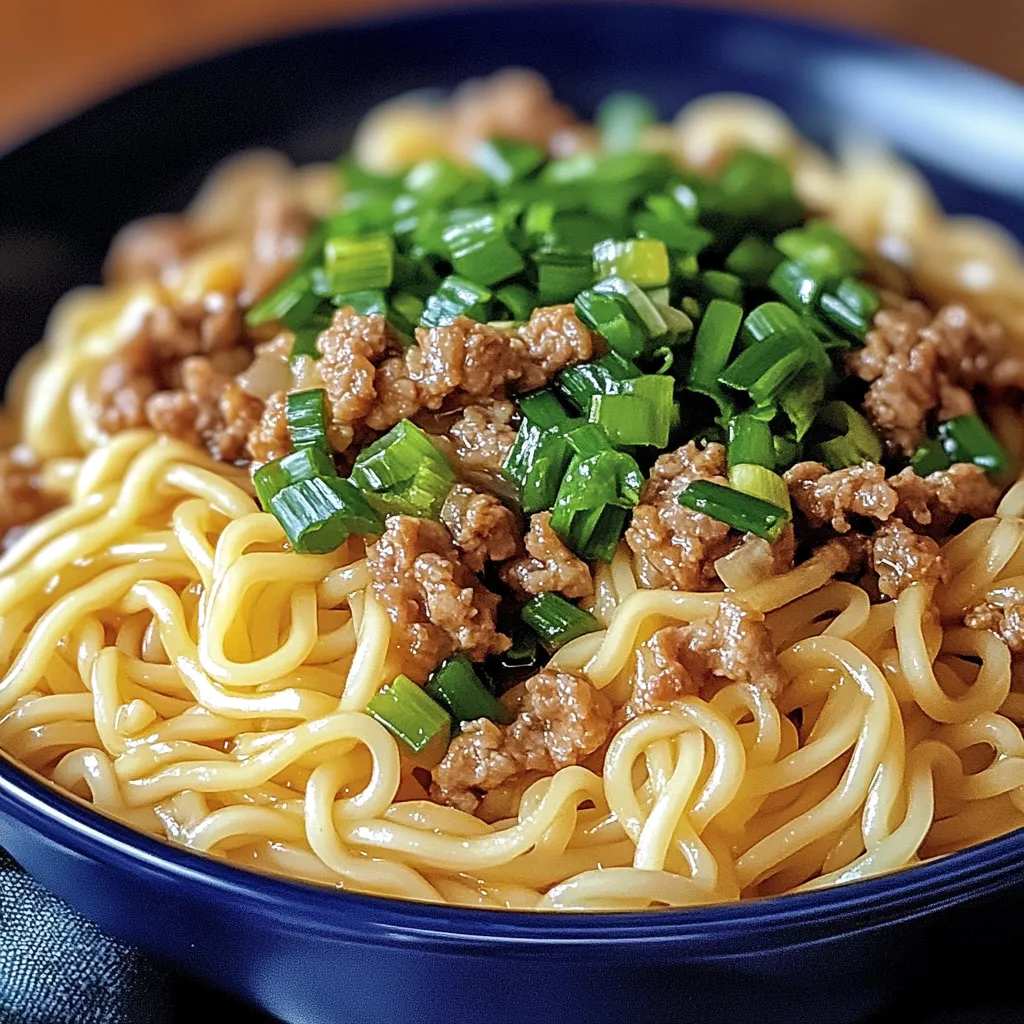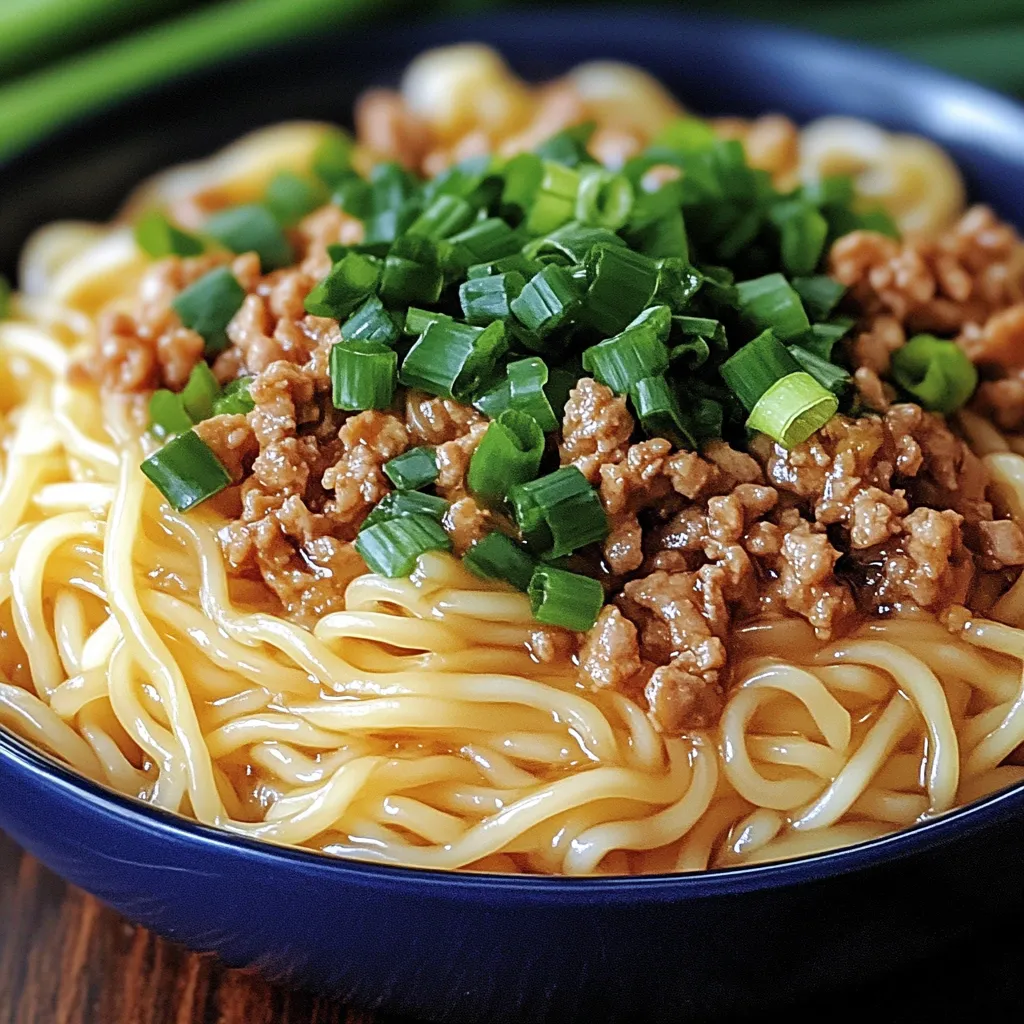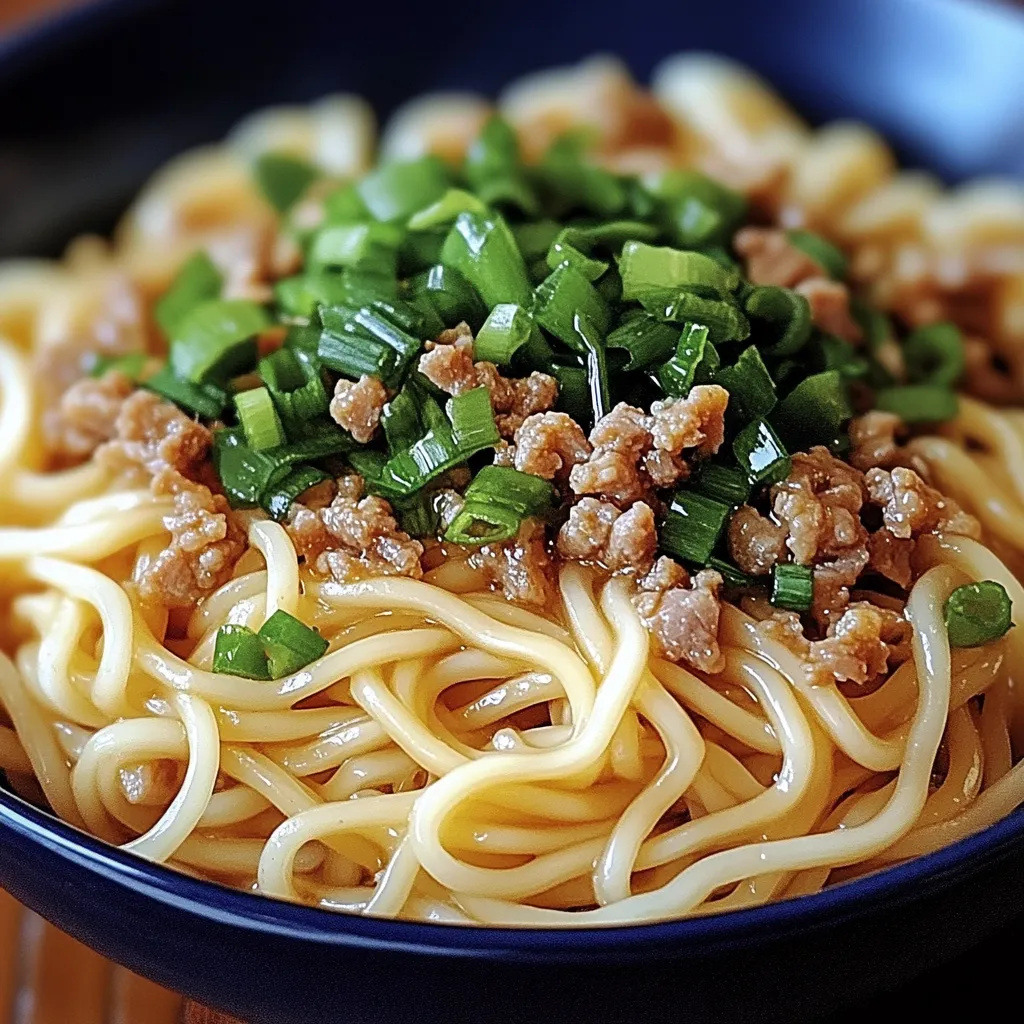 Save
Save
Slippery noodles coated in a fiery, nutty sauce that dances between spicy, savory, and tangy flavors with each twirl of your chopsticks. These dan dan noodles deliver that signature Sichuan one-two punch: the tongue-tingling numbness from Sichuan peppercorns followed by the warming heat of chili oil. The combination of creamy sesame paste, umami-rich soy sauce, and optional savory ground meat creates a bowl that's impossible to stop eating until you've chased down the very last noodle with your chopsticks.
I discovered my love for dan dan noodles at a small Sichuan restaurant tucked away in a strip mall. The first time I tried them, I was captivated by the complex flavors and that distinct tingling sensation that makes Sichuan cuisine so unique. After multiple attempts to recreate that experience at home, I finally landed on this recipe that brings all those incredible flavors together. What makes these noodles special is how they manage to be both comforting and exciting at the same time—rich and satisfying while also vibrant and awakening to the palate. Even my spice-cautious friend who initially declined a taste ended up requesting the recipe after trying 'just one bite.'
Bold Flavor Building Blocks
- Sesame Paste: Creates the creamy foundation—Chinese sesame paste is traditional, but natural peanut butter makes an excellent substitute
- Sichuan Peppercorns: Provide the signature numbing sensation—toasting and grinding them fresh releases their citrusy, floral aroma
- Chili Oil: Delivers the essential heat component—homemade offers the best flavor but good-quality store-bought works well
- Dark Soy Sauce: Adds depth and color—its slightly sweet notes balance the spice and create rich dimension
- Rice Vinegar: Brings necessary tang and brightness—this acid cuts through the richness and rounds out the flavor profile
- Ground Meat: Optional but traditional—pork is classic but beef or plant-based alternatives work beautifully
- Chinese Wheat Noodles: Form the perfect vehicle for the sauce—their chewy texture stands up well to the bold flavors
- Green Onions: Provide fresh contrast—their sharpness cuts through the rich sauce and adds visual appeal
Simple Preparation
- Toast The Peppercorns
- Start by toasting two teaspoons of Sichuan peppercorns in a dry pan over medium heat until fragrant, about 2-3 minutes. Shake the pan frequently to prevent burning. Once cooled, grind them to a powder using a spice grinder or mortar and pestle. This toasting step releases the essential oils and intensifies their unique flavor.
- Prepare The Sauce
- In a medium bowl, combine two tablespoons of sesame paste (or natural peanut butter), two tablespoons of soy sauce, one tablespoon of dark soy sauce, one tablespoon of rice vinegar, one tablespoon of chili oil (adjust to your heat preference), one tablespoon of sugar, the ground Sichuan peppercorns, two minced garlic cloves, and one teaspoon of minced ginger. Stir until smooth and well-combined. The sauce should have a balanced mix of nuttiness, heat, and tanginess.
- Cook The Protein
- If using meat, heat one tablespoon of vegetable oil in a wok or large skillet over medium-high heat. Add half a pound of ground pork or beef and cook until browned and crispy, about 5-6 minutes, breaking it apart as it cooks. Season with a pinch of salt. The slight caramelization adds another layer of flavor to the final dish.
- Boil The Noodles
- Meanwhile, bring a large pot of water to a boil. Cook eight ounces of Chinese wheat noodles according to package instructions until al dente. Fresh noodles will cook very quickly, while dried may take a bit longer. Reserve a quarter cup of the starchy cooking water before draining the noodles and rinsing briefly with cold water to stop the cooking process.
- Combine Everything
- In a large mixing bowl, toss the cooked noodles with the prepared sauce, adding a splash of the reserved cooking water if needed to thin the sauce to your desired consistency. The starchy water helps the sauce cling to the noodles. If using meat, fold it in at this stage. The heat from the freshly cooked noodles and meat will warm the sauce perfectly.
- Garnish And Serve
- Divide the noodles among serving bowls and top with chopped green onions and a sprinkle of roasted peanuts or sesame seeds for added texture. For the full experience, add an extra drizzle of chili oil on top. Serve immediately while hot, giving everyone a chance to stir everything together before digging in.
 Save
Save
I spent months trying to perfect this recipe, testing different ratios of ingredients and methods until I finally achieved that unmistakable flavor I remembered from the restaurant. The breakthrough came when I started toasting the Sichuan peppercorns myself rather than using pre-ground—their numbing quality was so much more pronounced and aromatic. What makes these noodles special is how each component plays an essential role in creating that perfect balance: the creamy nutty base from the sesame paste, the numbing spice from the peppercorns, the heat from the chili oil, the depth from the soy sauces, and the bright tang from the vinegar. It's this complex interplay of flavors that makes dan dan noodles truly addictive.
Regional Variations
The beauty of dan dan noodles lies in how they vary across regions and personal preferences while maintaining their essential character. Chengdu style emphasizes the ma la (numbing and spicy) qualities with extra Sichuan peppercorns and chili oil, often served with a thinner sauce and topped with preserved vegetables. Taiwanese version tends to be less spicy and more savory, with a greater emphasis on the sesame paste and sometimes the addition of pickled mustard greens for tangy contrast. Northern Chinese adaptation often includes more broth, creating a soupier version that's perfect for cold weather comfort. American Chinese restaurant style typically dials back the heat while increasing the sweetness and creaminess, making it more accessible to palates unaccustomed to traditional Sichuan spice levels.
Perfect Pairings
Complete your meal with complementary dishes that balance the bold flavors of these spicy noodles. Serve alongside cool cucumber salad dressed simply with rice vinegar, a touch of sugar, and sesame oil to provide refreshing contrast to the heat. For a more substantial meal, add Chinese greens like bok choy or gai lan stir-fried with garlic, which provide a clean, vegetal counterpoint to the rich noodles. Simple steamed dumplings offer another textural element that complements the noodles while extending the meal for larger appetites. For beverages, cold beer, particularly lagers or wheat beers, helps tame the heat, while unsweetened jasmine tea cleanses the palate between bites and aids digestion of this rich dish.
Make It Your Own
Adapt this versatile recipe to suit your personal preferences and what's available in your pantry. Vegetarian version replaces the ground meat with finely chopped mushrooms (shiitake or button) sautéed until golden and slightly crispy, maintaining the umami element while making the dish plant-based. Extra-authentic addition incorporates ya cai (Sichuan preserved mustard greens) sprinkled on top for traditional flavor and texture—look for this ingredient at Asian markets or online specialty stores. Gluten-free adaptation uses rice noodles or 100% buckwheat soba in place of wheat noodles and tamari instead of soy sauce while maintaining all the signature flavors. Quick weeknight version uses store-bought chili crisp (like Lao Gan Ma) in place of plain chili oil for added texture and complexity when time is limited.
Storage Solutions
Maximize enjoyment of these noodles with proper preparation and storage techniques that maintain quality and flavor. Store leftover sauce separately from noodles in an airtight container in the refrigerator for up to three days—the flavors actually develop and improve with time. For meal prep convenience, prepare a double batch of the sauce and portion into small containers, keeping it ready for quick meals throughout the week. If storing assembled noodles, keep in mind they will absorb sauce and soften over time—refresh leftovers with a splash of hot water when reheating and an extra drizzle of chili oil to revive their vibrancy. Freeze extra sauce in ice cube trays then transfer to freezer bags for individual portions that thaw quickly when a craving strikes—just cook fresh noodles for the best texture.
 Save
Save
These dan dan noodles have become my go-to recipe when I want to impress friends with bold flavors or simply treat myself to something special after a long day. What I love most is how they deliver such complex flavors from relatively simple ingredients. The combination of numbing spice, rich creaminess, and tangy brightness creates a truly craveable dish that's far more than the sum of its parts. While they may not be an everyday meal for those unused to spice, they're the perfect way to expand your culinary horizons and experience the unique pleasure of authentic Sichuan cuisine right in your own kitchen.
Common Questions About Cooking
- → What is the origin of Dan Dan noodles?
- Dan Dan noodles originated in Sichuan province, China. The name comes from the carrying pole (called 'dan dan') that street vendors would use to carry their noodles and sauce. These vendors would walk the streets with baskets containing noodles and sauce hanging from the pole, serving this delicious street food to customers.
- → Can I make Dan Dan noodles less spicy?
- Absolutely! The heat level is easy to adjust. Simply reduce the amount of chili oil or use a milder version. You can start with just 1 tablespoon and add more to taste. If you're sensitive to the numbing sensation, you can also omit the Sichuan peppercorns while still enjoying the other flavors in the dish.
- → What can I substitute for Chinese black vinegar?
- If you can't find Chinese black vinegar (Chinkiang vinegar), rice vinegar is the best substitute. You can also try balsamic vinegar mixed with a little water, which provides a similar depth of flavor, though slightly sweeter. Apple cider vinegar with a touch of soy sauce can work in a pinch as well.
- → Where can I find Sichuan peppercorns?
- Sichuan peppercorns can be found at Asian grocery stores, specialty spice shops, or online. If you have a local Chinese market, they'll definitely carry them. They're worth seeking out for their unique numbing sensation (called 'ma' in Chinese), which is characteristic of Sichuan cuisine.
- → Can I prepare any components of this dish ahead of time?
- Yes! The sauce can be made up to 3 days ahead and stored in the refrigerator. The meat topping can also be cooked in advance and reheated when ready to serve. Only cook the noodles right before serving, as they tend to stick together when stored. Assemble everything fresh for the best texture and flavor.
- → What type of noodles work best for Dan Dan noodles?
- Traditional Dan Dan noodles use Chinese wheat noodles of medium thickness. Fresh are best, but dried work well too. If you can't find Chinese wheat noodles, Japanese ramen noodles or even spaghetti can substitute. Look for something with a bit of chew that can stand up to the bold sauce.
